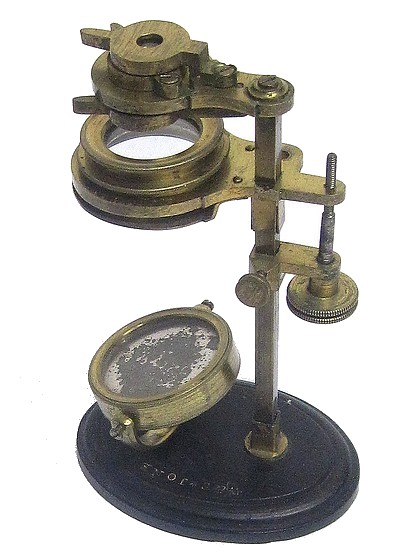
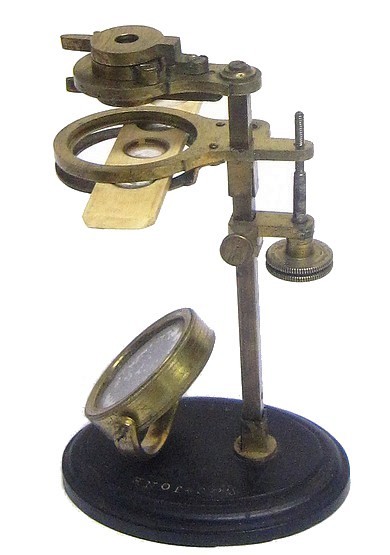
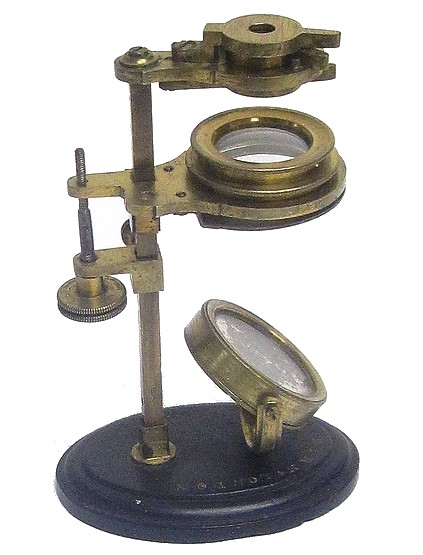
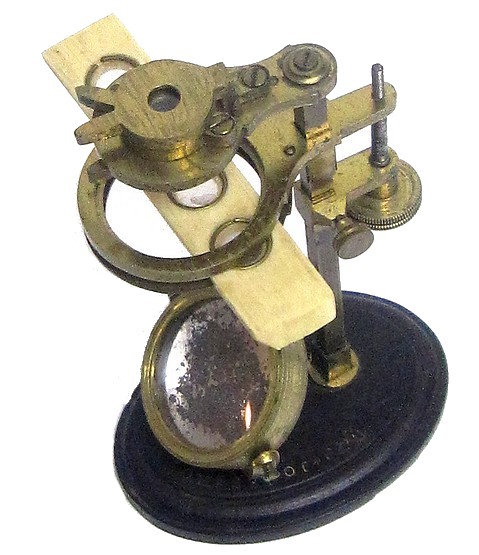
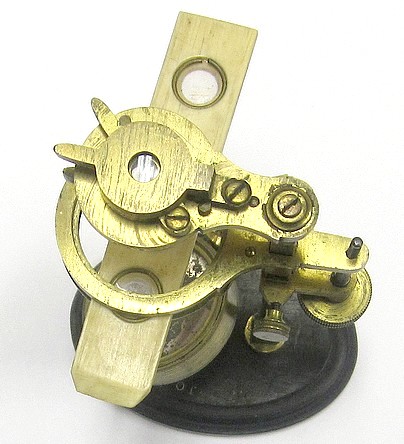
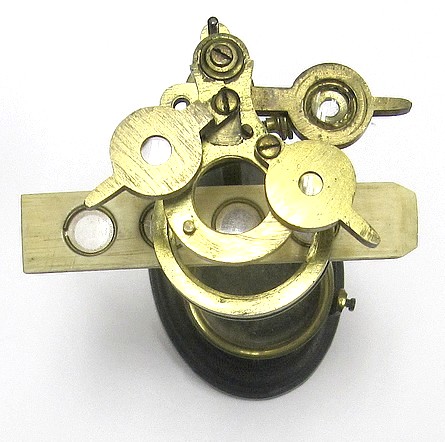
This microscope is signed on the ebonized wood base W. & S. Jones Holborn, London.
This diminutive microscope measures 4 1/4 inches in height. It was called by the makers the "Improved Botanical, or
Universal, Pocket Microscope". There are three objective lenses that swivel in and out of the
optical path and can be used in different combinations to vary the magnification. In addition,
below the first and second lens there is a table with a threaded aperture, which can be used to
attach an accessory high power objective or an objective with a Lieberkuhn reflector. The microscope
is focused by sliding the stage along the rectangular shaft. This particular example includes
a vertical thumbscrew fine focus mechanism; versions of this microscope were also made without this
fine focus attachment. While microscope was obtained without its case, it still retains its live-box.
By reversing the microscope in the base, it can function as a hand-held instrument with the base serving as a handle;
in that case, the mirror is removed and the microscope is pointed towards the light source.
The late 18th century origin of this type of botanical microscope has been credited to
Benjamin Martin and/or George Adams Jr. W. & S. Jones purchased the copyright to the Adam's
book, Essays on the Microscope, which illustrated a similar form of the microscope. In addition
to this botanical microscope, the Jones firm manufactured many of the models shown in that book.
The following are the directions of use that were supplied with the microscope:
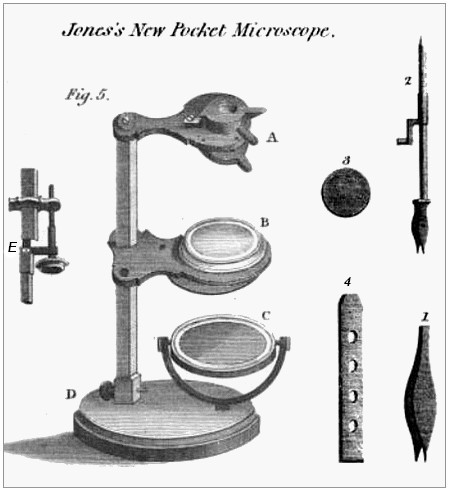
This microscope is adapted to the viewing of all sorts of objects, whether
transparent, or opake; and for injects, flowers, animalcules, and the infinite variety of the
minutia of nature and art, will be found the most complete and portable, for the price, of
any hitherto contrived.
Place the square pillar of the microscope in the square socket at the foot D,
and fasten it by the pin, as shown in the figure. Place also in the foot, the reflecting mirror C.
There are three lenses at the top shown at A, which serve to magnify the objects. By using these
lenses separately or combined, you make seven different powers, When transparent objects, such as are
in the ivory sliders No. 4, are to be viewed, you place the sliders over the spring, at the underside
of the stage B; then looking through the lens or magnifier, at A, at the same time reflect up the
light, by moving the mirror C below, and move gently, upwards or downwards as may be necessary,
the stage A on its square pillar, till you see the object illuminated and distinctly magnified;
and in this manner for the other objects.
For animalcules, you unscrew the brass box that is fitted at the stage B,
containing two glasses, and leave the undermost glass upon the stage, to receive the fluids.
If you wish to view thereon any moving insect, etc., it may be confined by screwing on the cover
of the two glasses, the concave is best for fluids. Should the objects be opake, such as seeds,
etc.; they are to be placed upon the black and white ivory round piece, No. 3, which is fitted
also to the stage B. If the objects are of a dark colour, you place them contrastedly on the white
side of the ivory. If they are of a white, or a light colour, upon the blackened side. Some
objects will be more conveniently viewed, by sticking them on the point of No. 2; or between
the nippers at the other end, which open by pressing the two little brass pins. This apparatus
is also fitted to a small hole in the stage, made to receive the support of the wire.
The brass forceps, No. 1, serve to take up any small object by, in order
to place them on the stage for view. The instrument may be readily converted into a hand
microscope, to view objects against the common light; and which, for some transparent ones,
is better so. It is done by only taking out the pillar from its foot in D, turning it half
round, and fixing it in again; the foot then becomes a useful handle, and the reflector C
is laid aside. The whole apparatus packs into a fish-skin case, 4 1/4 inches long, 2 1/4
inches broad, and 1 1/2 inches deep.
For persons more curious and nice in these instruments, there is contrived
a useful adjusting screw to the stage, represented at E. It is first moved up and down like
the other, to the focus nearly, and made fast by the small screw. The utmost distinctness of
the object is then obtained, by gently turning the long fine-threaded screw, at the same time
you are looking through the magnifiers A. In this case, there may be also added an extraordinary
deep magnifier, and a concave silver speculum, with a magnifier to screw on at A, which will
serve for viewing the very small and opake objects in the completest manner, and render the
instrument as comprehensive in its uses and powers, as those formerly sold under the name of
Wilson's Microscope.
Another identical example is located at the Science Museum, London.






